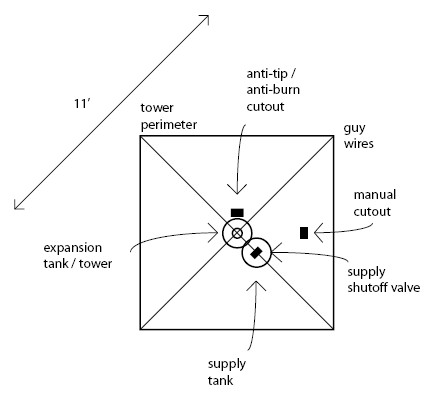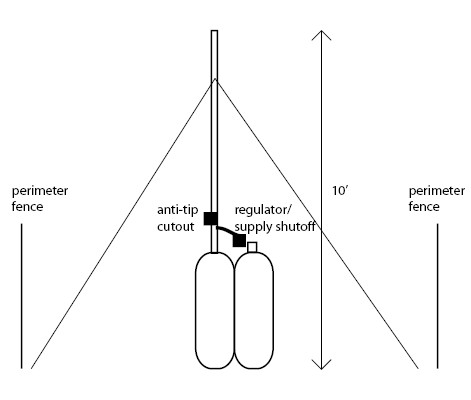


- one-switch full system shutoffs at control center and along length of installation
- system can be disabled by operator or safety team at control center
- system can be disabled at multiple points along length by safety team (or even a spectator if necessary)
- all system faults and operator/manual shutdowns disable entire system
- system is disabled between performances
- system run only with one of the project operator present and supervising;
- safety team member in vehicle can reach any point of installation quickly
- mobile operators on duty during performance times to check operation and shut down any tower immediately;
- safety team members in contact via radio
- full system inspection done before each performance to ensure towers stable and unaltered;
- igniters/towers visible to operator and safety spotter at control
| Figure 2: Tower Perimeter | Figure 3: Tower Elevation | |
 |
 |
- each tower has perimeter fence
- each tower is guyed and staked in place
- towers are above head height

- all supply shutoff valves fail to the closed position; if any fault is registered anywhere in the system or if the valves themselves fail, the fuel supply system to all towers is shut down
- all supply shutoff valves on all towers are closed when:
- system is non-operational
- system is put on standby from control center
- system shutoff triggered by fault condition (see below)
- system shutoff triggered manually
- burn sensor runs the length of the pressurized fuel path to sense burnout at any point
- all fuel pressure regulated
full system shutoff (fuel, electrical) if any of these conditions present:
- anti-tip cutout is triggered (tower is tipped or shaken)
- burn sensor is triggered (fire anywhere along low-level gas path)
- manual cutout is triggered (safety crew disables system)
- piping is propane- and pressure-rated
- valves and other components are industrial-strength